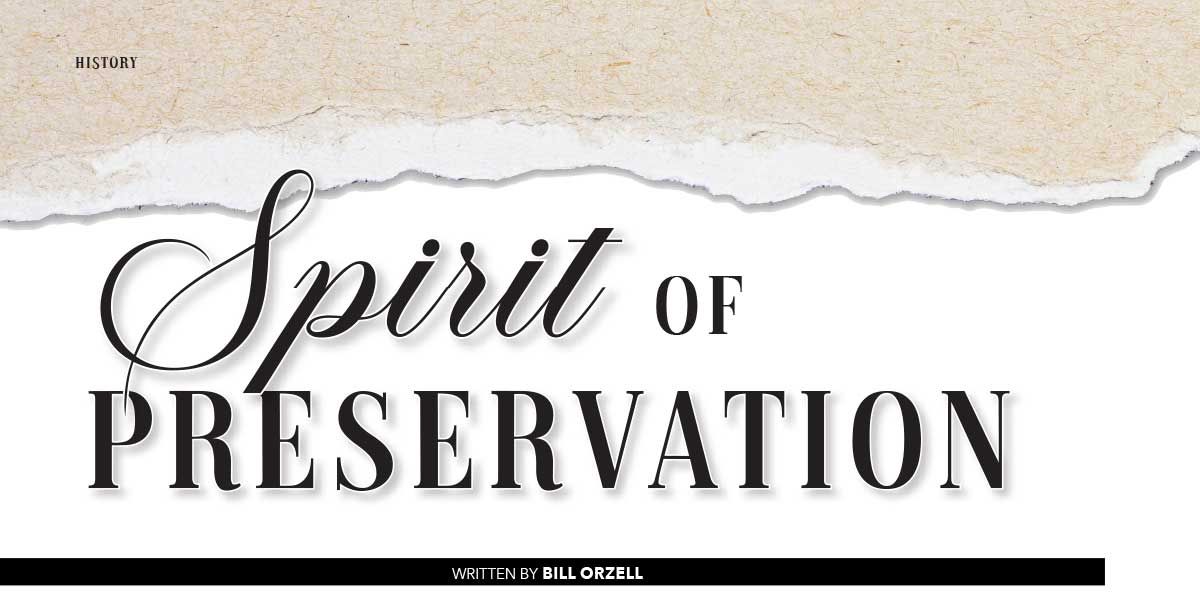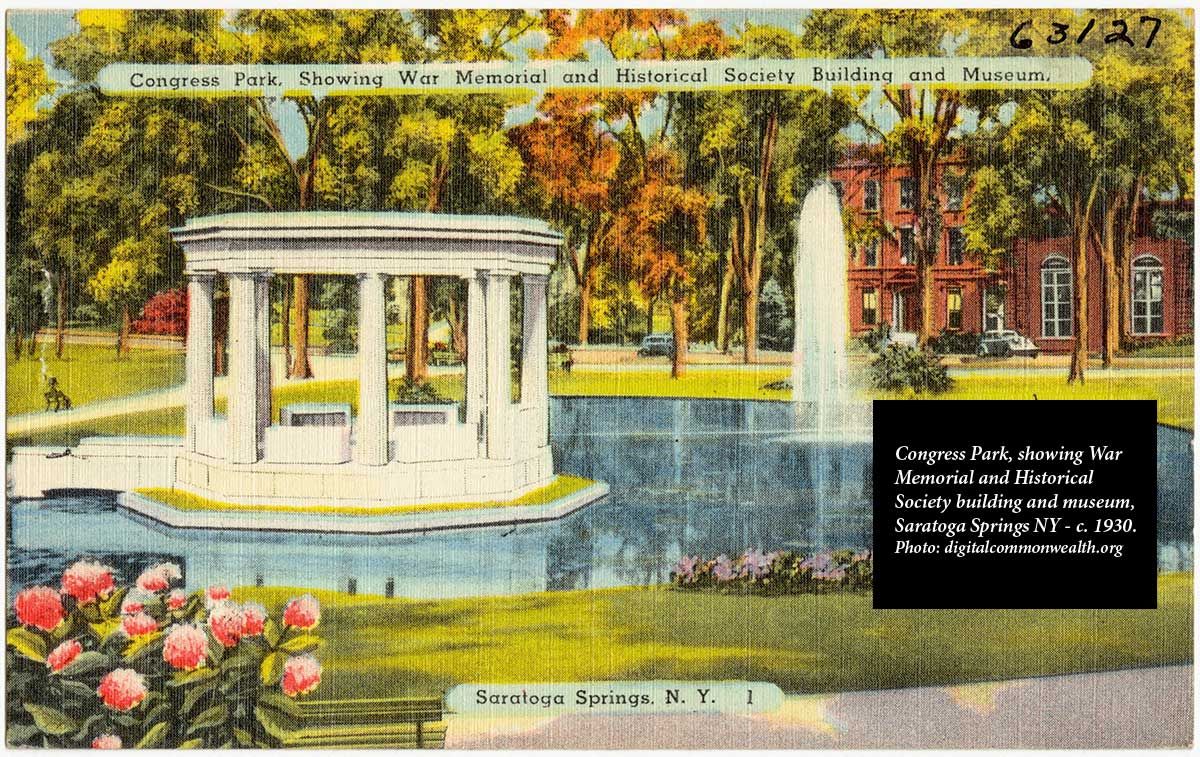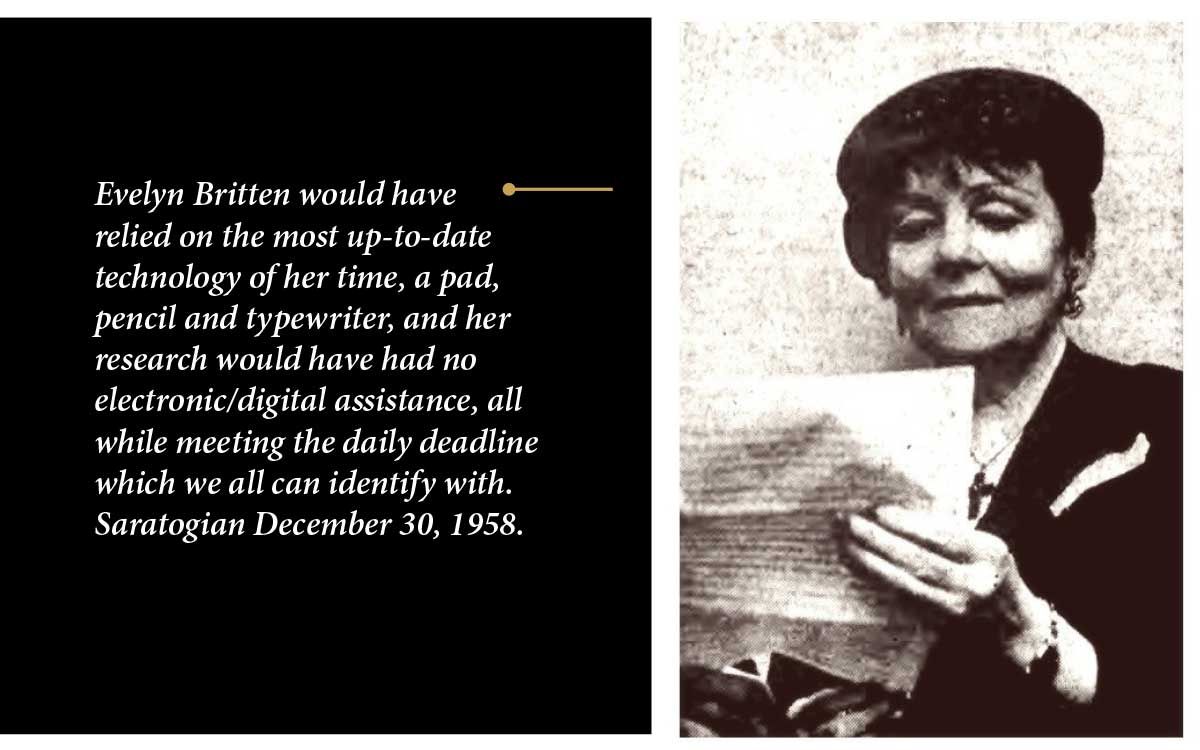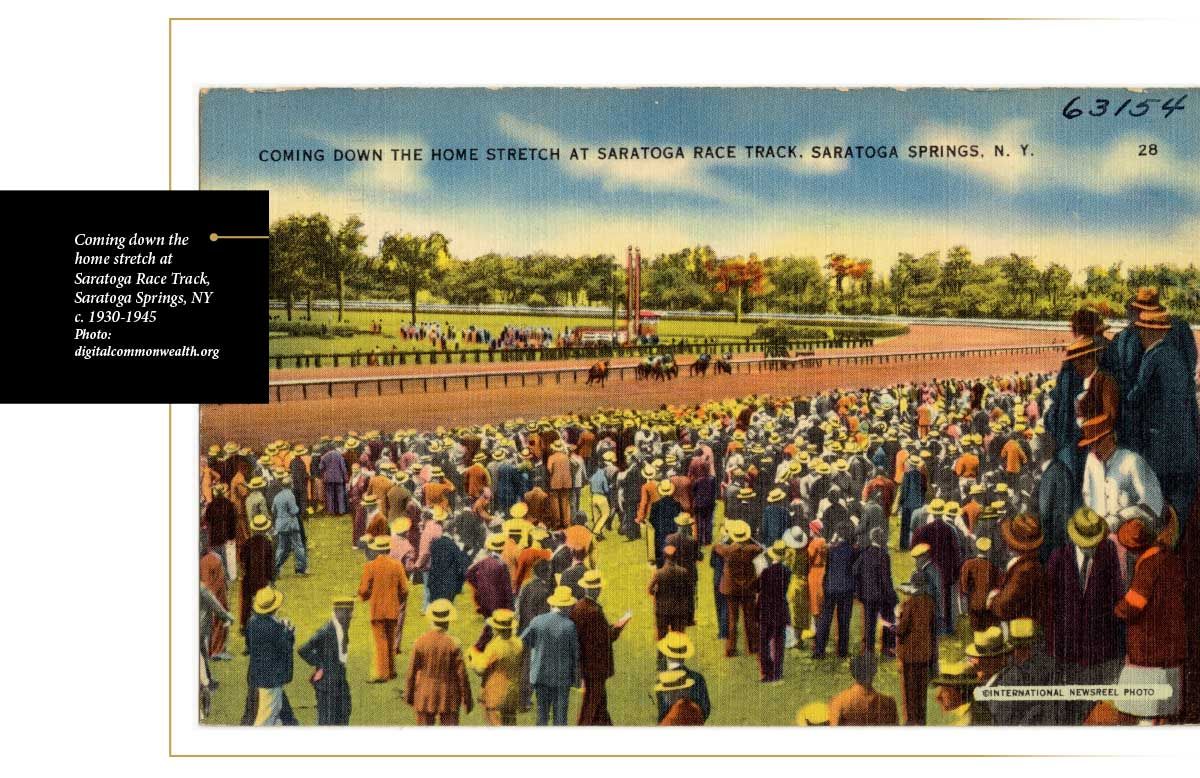
[From the 2025 Spring Magazine]
Action for keeping things as they are, especially items created by previous generations, protecting and preventing decay, and the narrative which describes their existence is preservation. In Saratoga Springs there is a strong spirit of preservation and steadfast action to carry this out, which is a major component of the community’s charm. This dedication, spirit and action began long ago, with the municipal creation of the City Historian position, and the first to fill that role, Evelyn Barrett Britten.
Evelyn Barrett Britten was the daughter of Mary Lloyd Kirby and Simon Wells Barrett, born in Saratoga Springs in 1891. Miss Evelyn M. Barrett was valedictorian at the Saratoga High School, class of 1909. Her family was communicants at St. Peter’s and she had been editor of The Recorder, the school newspaper. The young reporter was also on the staff of the Saratoga Sun before graduation, preparing herself for her life’s career with the Saratogian. When a society column was established she took the pen name Jean McGregor, writing under that nom-de-plume during her employment by the Saratogian. Evelyn had a sister Irene, who was two years her senior, and demonstrated to her younger sibling the capabilities of a young woman in the working world, establishing the Business and Professional Women's Club.



The youthful reporter had a firm grip of local events, and the interrelated matters leading up to them. In 1922 Mayor James McNulty appointed Evelyn the first City Historian of Saratoga Springs. It seems comical presently to read the official records; her salary was $100 per year.
In 1926 Mayor Clarence Knapp appointed postmaster John Corey City Historian, a post he held for twenty years. In Such Was Saratoga by Hugh Bradley (1940), the author states that the former postmaster's middle name was Morrissey, and he was descended from Saratoga Race Course founder John Morrissey, and that his recollections are a major part of Mr. Bradley's book.
In the late 1920’s Evelyn Barrett advocated for a War Memorial in Congress Park. Architect Samuel Adams Clark had an interesting connection with Saratoga Springs. He lived and practiced in Manhattan, and his wife Gertrude and cousin Winston Churchill were the grand-children of Leonard Jerome, who had established the Jockey Club and three race tracks and was recently elected to the NMR’s Hall of Fame.
Gertrude’s father, J. Henry Alexandre was a member of the syndicate which William C. Whitney and Richard T. Wilson assembled to purchase the Saratoga Race Course in 1900. Mr. Alexandre purchased property on Church Street, part of which became the Saratoga Golf and Polo Club. Architect Clark designed the race track recreation center and also the enlargement of the Clubhouse into its present Turf Terrace configuration in 1928, and began work on the War Memorial. Miss Barrett was fond of writing about the Clark’s. On June 29, 1928 she wrote,
“In a conversation with Mr. Clark before he left the city, he told me this morning, that he plans to erect a summer home for his family on property of The Saratoga Golf Club of which he is the owner. Mr. Clark, you will recall, recently sold the summer home, Cady Hill, which he and Mrs. Clark and family occupied for so many seasons at The Geysers to Harry Payne Whitney."
As the purveyors of the thoroughbreds could recite the pedigrees of the swift performers on the track, reporter Evelyn Barrett tracked down the pedigrees of the Spa’s visitors.
In 1937 she reported about herself as Secretary of the Saratoga Historical Society, receiving a letter from Congressman Harold Cluett advising that he had introduced a bill to provide for the creation of the Saratoga National Historic Park. The Society had made this request to preserve the historic Battlefield, the lynchpin of American independence, for a grateful posterity.

Walter A. Britten was born in 1888 near Bemis Heights and had athletic ability as a youngster, and his talents gave him the opportunity to play professional minor league baseball. When his diamond skills deserted him, he became a typesetter on the Ballston Journal’s news press. In 1907 he married Margaret J. McCarthy, and the couple had two children, John and Agnes. Margaret died in 1920 and soon after Walter joined the Saratogian staff, beginning a 27 year career with the daily. Evelyn and Walter violated that old rule “never get your honey where you make your bread & butter,” and married. She moved to the Britten home on Church Street with her husband, while her two step-children were already treading the paths they had chosen into their future. Agnes Britten became a teacher, attending the Arizona State Normal School, where she met Lee Patton from Texas, whom she married in 1929.
Mrs. Britten, as Jean McGregor, had a regular feature called Tea Table Chat with the subtitle; “Social Affairs, Personals, Women’s Interests,” which noted many distinguished personages arriving to “take the cure.” Also, the entire world of celebrity would make an annual August pilgrimage to the famous Spa for track season. Even the Great Depression did not stop the excitement each summer. Mrs. Britten had a clubhouse pass and a guaranteed seat at the table, whether that might be restaurant, ball room or roulette table. For decades she detailed the intrigues of those visiting Saratoga Springs, the resident population, and the societal interface of a global resort destination. This side of news was mostly uplifting, with the comings and goings of the important
and famous, business successes, and racing’s inbred horsey set. In her slightly condescending style, her readers learned of the many parties and social gatherings they had not been invited to. She also identified the sick and infirm, and the eventual fate which awaits us all. Occasionally she included items which must have broken her heart, such as reporting the March 1937 death of her 3-day-old infant grand-daughter in the Appalachian ridges of West Virginia.
World War II was an epic global struggle which fostered many depravities, and cost enormously in lives and treasure. The difficulties on the home-front were many across the country, and Saratoga Springs was separated from the unique benefits derived by thoroughbred competition. Racing was conducted during the War, but downstate during 1943-45, as Saratoga was considered too distant. Grass and weeds grew wild on the Saratoga track as the facility was used as a collection and storage area for military equipment. Mrs. Britten’s step-son John, who had started his own family, served in the US Navy during the conflict.
Atomic weapons would preclude the invasion of Japan and force the conclusion of World War II in August of 1945. Racing’s return to Saratoga would wait until the summer of 1946 to be re-inaugurated, and Mrs. Britten as Jean McGregor could not wait to get back into the swing at the Spa. Many articles told her readers then, and those interested now, who was coming to Saratoga, and where they stayed, being a hotel or rental cottage, and what they did at the track and the Lakehouses afterward.
Walter Britten was a bastion of the Ballston Spa fire company for decades, and active in the County Republican Party. He supported and was part of his spouse’s quasi-professional/personal interests in the Red Cross, P.T.A., D.A.R., the Saratoga Historical Association, American Legion Auxiliary, and the Katrina Trask Garden Club. When she was once again appointed City Historian by Mayor Addison Mallery in 1946, perhaps confined by the precepts of an earlier era, she was very comfortable as identifying as Mrs. Walter A. Britten.
In September of 1946, the City Historian announced she was collecting copies of books written by Saratogians, and books that had to do with the history of the city and county, which would be placed in the public library when that facility become an actuality, in a section devoted to the history of the community. The SSPL’s Saratoga Room has become a fabulous resource.
In 1948 Mrs. Britten began presenting a weekly newspaper story of early times, titled the Saratoga Chronicles, and she also pioneered a 15 minute Sunday radio show, detailing interesting items from the community’s remarkable past.
In the final months of the War, son-in-law Lee Patton accepted a position at West Virginia University, which would make him an assistant football coach, and head basketball coach of the Mountaineers. He and his wife and daughters would frequently visit Mr. and Mrs. Walter Britten, often using their Church Street home as a base, from which the coach attended basketball conferences in the northeast. On Valentine’s Day 1950, the Mountaineers basketball team was making its way from Morgantown to State College, for a matchup with the Penn State Nittany Lions. Coach Patton was well-liked by his players, who labeled him “Worry-bird,” for his habit of considering all sporting contingencies. The WVU team was proceeding in an automobile caravan, with publicity director Forest Crane driving one car, while Coach Patton in the passenger seat discussed strategy with three players in the back seat. On the Pennsylvania Turnpike, near Bedford, a car traveling in the opposite direction lost control and jumped the median and crashed head-on into the basketball team. The driver of the out-of-control vehicle was killed, and Mr. Crane and Coach Patton received serious injuries; however, the players were able to leave the hospital after treatment. Coach Patton managed to return to his Morgantown home in early March, apparently recovering, but he succumbed to his injuries on March 8.

Because of a heart ailment, Mrs. Britten retired in 1952 from daily duties at the Saratogian, although she continued contributing many articles written under her name as the City Historian. It was very disappointing in the autumn of 1954 for the City Historian to bear witness to the work of vandals that damaged historic holdings at Canfield Casino.
In 1957 Mrs. Evelyn Barrett Britten derided Governor Harriman with what she perceived as a change of heart on historic monuments, with regards to a proposed hotel in Congress Park. She also mentioned some of the prominent racing people of that time who disapproved of a Park hotel. One was Humphrey Finney, president of Fasig-Tipton Sale Co. who advised “Don’t ruin your Park.” That autumn, Walter A. Britten died at his home 99A Church St, of a coronary ailment.
On July 17, 1959 the Saratogian reported about her book,
“written by Mrs. Walter A. Britten, city historian of Saratoga Springs, is being privately published at her own expense. She said she has felt for a long time since the publication of her first book by The Saratogian in 1947, that the research material and the stories of early Saratoga Springs history she has unearthed, should be preserved in book form, and so has undertaken that task”
Mrs. Britten was disappointed that others did not feel the same way about some of the buildings she cherished in Saratoga Springs, one of these being Convention Hall, which opened in 1893 but by 1965 was considered obsolete. Her efforts to preserve this structure became moot later that year when teenagers smoking in the derelict Columbian Hotel on Broadway set that structure ablaze. High winds blew flaming brands across the street, igniting the roof of Convention Hall, and the building could not be saved. Her work at the Walworth Museum and Canfield Casino continued with greater emphasis after witnessing ash and ruin on Broadway.
Evelyn Barrett Britten died July 12, 1969 and her funeral was held at St. Peter’s a few days later on July 16. She was laid to rest in the church cemetery. The final line on her tombstone demonstrates the pride she took in her hometown and the position she fulfilled to the last; it reads “City Historian.” My copy of Chronicles of Saratoga is autographed by the author, where she wishes some purchaser in posterity, “the best of luck.”